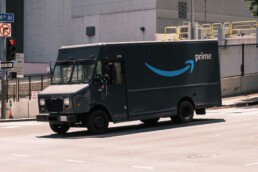How Amazon Shipping Could Shake Up the Parcel Delivery Industry
The parcel delivery industry has long been dominated by giants like UPS and FedEx. However, with the relaunch of Amazon Shipping parcel delivery, a new force is emerging, poised to disrupt traditional logistics models. Amazon’s move into this space is significant not just for e-commerce fulfillment but also for third-party logistics (3PL) providers, small businesses, and even consumers. In this blog, we’ll explore how Amazon Shipping parcel delivery could impact the industry, offering opportunities and challenges alike for all parties involved.

A New Era for Parcel Delivery
Amazon has developed a massive logistics and fulfillment network, giving it the infrastructure to manage millions of shipments every day. However, Amazon Shipping represents a shift in strategy. It offers small- and medium-sized businesses the ability to use Amazon’s extensive delivery network for packages outside of Amazon orders, shaking up traditional delivery services.
Amazon’s decision to enter the parcel delivery market comes at a time when e-commerce fulfillment has grown dramatically. Businesses increasingly need efficient shipping and delivery options to meet rising customer expectations, especially for same-day and next-day delivery. By leveraging their logistics expertise, Amazon Shipping is positioned to challenge the existing order of warehousing and distribution models.
Key Differentiators of Amazon Shipping
Amazon Shipping is set apart from traditional carriers by offering simplified rates, faster delivery times, and fewer hidden fees. Small- and medium-sized businesses that don’t have the resources to negotiate complicated contracts with carriers like FedEx and UPS could find Amazon’s streamlined service appealing. These businesses may also benefit from reduced shipping surcharges and access to Amazon’s extensive order tracking and management tools, which will help improve order fulfillment solutions.
Moreover, Amazon Shipping also integrates well with various e-commerce platforms, providing sellers a chance to optimize their delivery operations, ultimately improving supply chain optimization and inventory management. By tapping into Amazon’s vast network, even businesses without the capital to invest in their own fulfillment center can still offer competitive delivery services.
Impact on the Supply Chain
The introduction of Amazon Shipping parcel delivery is a game-changer for the parcel delivery sector, and it raises questions about how traditional shipping companies will respond. For example, third-party logistics providers and 3PL technology solutions could benefit from Amazon’s entry into the market by partnering with them for better inventory tracking and faster shipping times.
However, there’s potential disruption as well. Supply chain management systems will need to adjust, especially for businesses heavily reliant on traditional carriers. As Amazon expands its last-mile delivery services, competing companies will need to improve their value-added services (VAS), such as reverse logistics, bulk shipping, and kitting and assembly, to maintain their edge.
Transitioning from Fulfillment Giant to Parcel Delivery Leader
While Amazon has long been a leader in fulfillment services, offering multi-channel fulfillment and scalable fulfillment solutions to sellers, its foray into parcel delivery is relatively new. Nonetheless, its vast network of warehousing and distribution centers, combined with an advanced transportation management system (TMS), provides a solid foundation for disrupting the delivery industry.
Amazon Shipping could become a critical player for businesses aiming to reduce costs while increasing efficiency. For example, its focus on carrier selection and management and customs brokerage for international shipping could make it a viable alternative to traditional shipping companies for cross-border trade. Additionally, with Amazon’s existing expertise in freight consolidation, the company could further optimize its shipping network to reduce transit times and costs, making them a formidable competitor in parcel delivery.
The Role of Technology in Amazon Shipping
One of the most critical factors in Amazon Shipping’s potential success is its integration of technology. The service offers robust inventory management and order accuracy tools, which help streamline operations for sellers and improve the customer experience. These tools, paired with Amazon’s cloud-based warehouse management system (WMS), ensure real-time order tracking and faster shipping times.
Amazon Shipping’s use of data and automation in their fulfillment center operations ensures higher order accuracy and quality control, giving them a competitive advantage. These systems allow for inventory forecasting and demand planning, which can be crucial during peak seasons, ensuring businesses can meet consumer demand without delays.
Challenges Facing Amazon Shipping
While Amazon Shipping parcel delivery holds immense potential, there are challenges that could hinder its growth. One of the key concerns is Amazon’s dependence on other carriers, such as UPS and the U.S. Postal Service, for certain deliveries, particularly in more remote areas. This reliance could create bottlenecks, especially during high-demand periods like holiday seasons or during Amazon Prime events.
Another challenge lies in building trust with businesses. Larger enterprises may be reluctant to shift away from existing carrier relationships with volume discounts. Also, there’s uncertainty surrounding how Amazon will prioritize shipments, especially if conflicts arise between deliveries for Amazon.com and Amazon Shipping customers.
Long-Term Implications for the Industry
The future of Amazon Shipping parcel delivery is promising, but it will take time for the service to become a major player in the parcel delivery space. In the short term, it’s likely that Amazon will target smaller, e-commerce fulfillment providers who will benefit from their straightforward pricing and cross-docking solutions. Over time, as Amazon builds trust and expands its capabilities, it could pose a significant threat to existing delivery giants.
The long-term implications of Amazon Shipping for the parcel delivery industry are clear: traditional carriers will need to innovate and offer better third-party logistics solutions and enhanced services such as freight forwarding, freight rate negotiation, and improved freight audit and payment services. Businesses and consumers alike could benefit from more competitive shipping rates, faster delivery options, and improved customer experiences.
Beginner’s Guide to Third-Party Logistics (3PL)
The world of e-commerce is always changing, therefore understanding the roll of Third-Party Logistics is integral to keeping up. In light of this our beginner’s guide to third-party logistics (3PL) will delve into the essential aspects, offering insights into fulfillment services, warehousing, and much more.
Read More…
Amazon Shipping’s reentry into the parcel delivery market represents a pivotal moment for the industry. As the service continues to evolve, it will likely shape the future of shipping and delivery for businesses of all sizes. By offering more accessible, cost-effective, and reliable options, Amazon Shipping could significantly impact traditional delivery services and reshape how companies approach order fulfillment.





